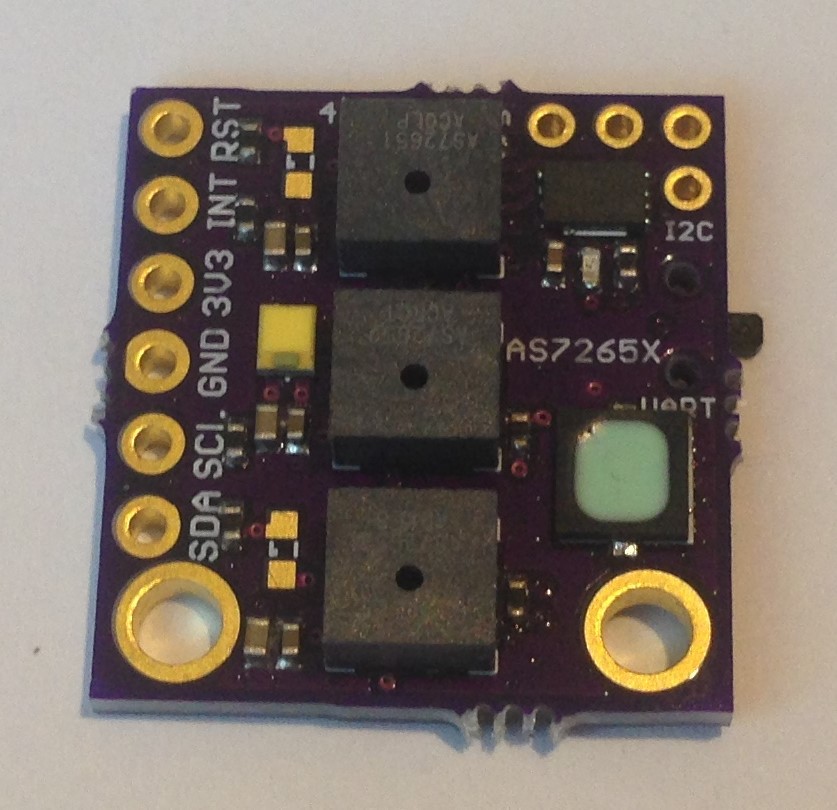22 July 2018
Got the latest design revisions back from OSH Park and put three together. I consider these the first "production" boards even though I assembled them by hand; they are the final design and ready for a pilot production run in China:

Also, I was able to buy some of the AS72651 and AS72652 ICs so these are the first boards that have all three of the actual AS7265X ICs: AS72651, AS72652, and AS72653. The previous designs used AS7263 for the AS72651 IC and AS7266 for the AS72652 IC. I bought the AS7263 and AS7266 directly from AMS and these are supposed to be identical to the AS72651 and AS72652, respectively. But probably pre-production variants or something. Anyway, these three boards use the "proper" or more likely "production" versions of the AS7265X chip set.


Everything works as expected. The switch I added to the back changes the mode from UART to I2C; in the former case SDA (RX) and SCL (TX) serve as the UART port. The fact that these have 4K7 pullups doesn't seem to impede the serial UART data flow. I prefer I2C but it is nice to have the option at the flick of a switch. I suppose a solder jumper would have done as well and saved a bit of BOM cost.
I should be possible for the user to use a soldering iron to add 0603 leds of his/her choice for the other two source leds. I like having the broad-band IR source led (the bluish square thingy) but this adds significanlty (~$5) to the BOM cost. I think the spectrometer works well-enough with only the broad-band white source led (smaller yellowish thingy) for many applications, so I am kind of on the fence about the benefit of having the IR led too.
The total cost ended up being about $21 without the IR led and about $26 with. So this meets the goal of a "Compact, $25 Spectrometer". I listed the final design version (v.02c) of the AS7265X spectrometer as a product on Tindie for $49.95 with the option of adding the broad-band IR led for $10 extra. Considering I will assemble these by hand for a while to test demand, this is still a bargain. But for the cost conscious and/or those that want an assembly challenge, the design files and BOM are open source. I will post the final design and BOM on the project page.
 Kris Winer
Kris Winer
Discussions
Become a Hackaday.io Member
Create an account to leave a comment. Already have an account? Log In.
Thanks for the tip on the Spectralon, finding a good and cheap normalization standard has been difficult.
Are you sure? yes | no
Hi,
good to hear the design is ready.
Just quick remarks:
- For calibration use a white standard. Paper is not good because of the fluorescence in the UV (not cellulose but filler material). Use white teflon, ideally micro-porous Teflon sheets (this is sold under the brand Spectralon, but normal teflon sheets are cheaper.) There are no absorption bands from UV to NIR and it has almost ideal scattering behaviour (lambertian, no specular reflection).
- Normalize spectra by dividing through white standard. You also have to check if you are still linear in channel intensity by changing distance. Probably not because the LEDs have different emission angles and distance
- Start with the tristimulus sensors. AMS sells the same sensors to get XYZ values. If you know the value from a colorimeter (AMS sensor in e.g. ColorPin, calibrated monitor, visual check of specimens' color with sRGB monitor) you should be able to reproduce the value and the color appearance.
- Please connect the channels with anything but straight lines. Splines or bar charts? The lines are annoying ;)
Are you sure? yes | no